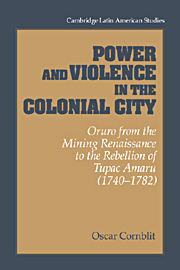 Power and Violence in the Colonial City
Power and Violence in the Colonial City Book contents
- Frontmatter
- Contents
- List of figure, maps, and tables
- Preface
- Map 1 Present-day Bolivia and surrounds
- Map 2 Principal routes of the Viceroyalty of Peru (second half of the eighteenth century)
- 1 Oruro between two epochs: a mining cycle
- 2 Under Spanish law
- 3 Oruro in 1741: details of a stormy election
- 4 The people
- 5 “Madmen, comedians, and hypocrites”
- 6 Captains of shipwreck
- 7 Returning to the known
- 8 “The fruits of the earth”
- 9 The end of an epoch: the Indian uprisings of 1780–1781
- 10 Oruro in the economic and geopolitical context of the epoch (c. 1780–1781)
- 11 The Oruro uprising
- 12 The voice of the rebels
- 13 Picking up the pieces
- Appendix A Indian raids on Oruro, 1781: testimonies
- Appendix B Testimonies of inhabitants of the city
- Appendix C Table of public jobs in Oruro, 1730–1784
- Bibliography
- Index
- CAMBRIDGE LATIN AMERICAN STUDIES
9 - The end of an epoch: the Indian uprisings of 1780–1781
Published online by Cambridge University Press: 30 March 2010
- Frontmatter
- Contents
- List of figure, maps, and tables
- Preface
- Map 1 Present-day Bolivia and surrounds
- Map 2 Principal routes of the Viceroyalty of Peru (second half of the eighteenth century)
- 1 Oruro between two epochs: a mining cycle
- 2 Under Spanish law
- 3 Oruro in 1741: details of a stormy election
- 4 The people
- 5 “Madmen, comedians, and hypocrites”
- 6 Captains of shipwreck
- 7 Returning to the known
- 8 “The fruits of the earth”
- 9 The end of an epoch: the Indian uprisings of 1780–1781
- 10 Oruro in the economic and geopolitical context of the epoch (c. 1780–1781)
- 11 The Oruro uprising
- 12 The voice of the rebels
- 13 Picking up the pieces
- Appendix A Indian raids on Oruro, 1781: testimonies
- Appendix B Testimonies of inhabitants of the city
- Appendix C Table of public jobs in Oruro, 1730–1784
- Bibliography
- Index
- CAMBRIDGE LATIN AMERICAN STUDIES
Summary
The forty-one years of Oruran history from 1740 to 1781 culminated with one of the most tragic and violent chapters in the life of colonial Spanish America: the great rebellion led by Tupac Amaru (José Gabriel Condorcanqui).
The bloody events that occurred in Oruro in February, March, and April 1781 were, in fact, a regional occurrence within the context of the great uprisings that spread from the south of present-day Peru to the north of what is now Argentina from the middle of 1780 to the middle of 1782.
In fact, throughout the century there had been frequent conflicts and mutinies against the officers of the crown, especially against the corregidores. In 1730, for example, there was a rebellion in Cochabamba. In the same year, Velar de Córdoba headed the previously mentioned uprising of Oruro, which in one way marked the division of the factions of subsequent years; similar movements occurred in 1742 in Tarma and Jauja, led by Juan Santos Atahualpa. In 1750 the corregidor of Huarochiri was murdered; in 1776 the same fate befell Jerónimo Sagasti, corregidor of the province of Chumbivilcas.
These movements were not always repressed with violence. At times the authorities even yielded to demands for lower taxes.
Thus, by 1780 the colonial officials were already familiar with local mutinies and uprisings.
Nevertheless, those of 1780–1 were exceptional for their brutality on both the Spanish and the Indian sides. In the latter case, there was a striking contrast between their conduct in periods of peace – when their submission and tolerance for abuse was at times difficult to comprehend – and the violence with which they responded to the call to rebellion made by their leaders.
- Type
- Chapter
- Information
- Power and Violence in the Colonial CityOruro from the Mining Renaissance to the Rebellion of Tupac Amaru (1740–1782), pp. 110 - 128Publisher: Cambridge University PressPrint publication year: 1995


